How is trenchless pipe laying: method features + work example
During the construction of new pipelines, as well as in the repair or replacement of old communication lines, trenchless pipe laying is actively used.
A variety of methods allows you to choose the best method - depending on the complexity of the site or the density of development.
In this material we will talk in detail about the methods of trenchless laying of pipelines and their distinctive features.
The content of the article:
Advantages and features of BPT
The obvious advantages compared to excavation when digging trenches are the following aspects:
- reduction of the terms of work;
- minimization of expenses for restoration of improvement;
- maintaining the operation of infrastructure in normal mode;
- reduced impact on environmentally sensitive areas.
The choice of the method of trenchless laying of the pipeline depends on the diameter of the required well, the characteristics of the landscape and soil, the material of the laid pipes, the presence or absence of existing communications.
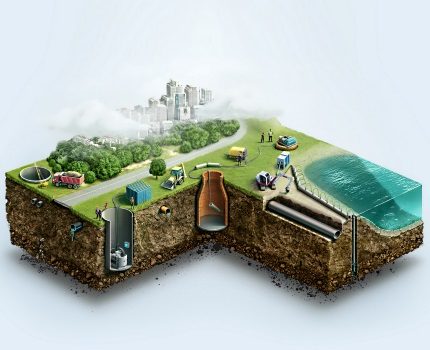
There are many options for implementation, but among them four main methods can be distinguished: rehabilitation, punching and puncture of the soil, horizontal directional drilling.
Reconstruction and replacement of the pipeline by rehabilitation
The rehabilitation method is used in those cases when during the audit the need for a full or partial replacement of an existing pipeline was identified.
With the help of rehabilitation, the following problems are effectively solved:
- clogging of pipeline sections and cracking;
- destruction of local branches of communications with tree roots;
- risk of pipe breaks due to corrosion.
Depending on the state of communications and tasks, they resort to relining or renovation technology.
Relining technology or “pipe in pipe”
Relining is a rehabilitation option used for pipelines in which a slight reduction in diameter is possible. If the real life of metal pipes is exhausted and there are fears that they work until the next breakthrough, then they are preliminarily cleared of deposits of calcium, rust and sand.
A polyethylene liner is prepared having the form of a sleeve, which is preliminarily filled from the inside with a polymer composition uniformly distributed over the entire length. This polymer stocking under pressure of water or air is smoothed inside the pipe, while turning it inside out so that the previously applied composition adjoins the walls of the pipeline.
After the sleeve has filled the entire segment of the worn pipeline, the polymerization process is carried out under the influence of temperature. As a result, both the strength of communications and their throughput increase.
Another relining technology involves laying new polypropylene pipes from within existing old ones. In this way, steel, ceramic, asbestos-cement, cast-iron, concrete and reinforced concrete pipelines with a diameter of 200-315 mm are replaced.

It should be borne in mind that in places PVC pipe joints a seam of about 15 mm is formed, and from it it is necessary to measure the gap between the inner diameter of the old pipe and the outer surface of the new pipe.
Due to the low hydraulic resistance of plastic pipes, the throughput does not deteriorate even with a decrease in diameter.
Renovation of pipelines by renovation technology
Another option for rehabilitation is renovation. It differs from relining by a much less sparing attitude to existing communications, which are destroyed and compacted into the ground, creating a protective shell for a new pipeline, which often has a larger diameter.
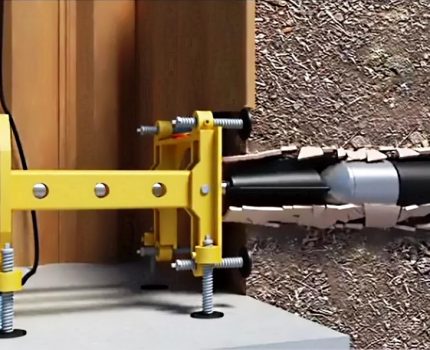
For such trenchless pipe laying, specialized equipment is needed - a pneumatic hammer machine with a cone-expander equipped with cutting ribs is used. The video under the article clearly shows how the cone copes with a pipe of 6 mm steel.
The working mechanism is fixed to the traction cable, after which modules of PVC pipes are connected in stages, the length of which can vary from 600 to 1000 mm, depending on the width of the well. The pneumatic hose is connected to the compressor, after which it is passed through the connected modules together with the safety cable.
The entrance to the replaced pipeline expands and a pneumatic hammer machine is introduced into it. Moving along the communications, she breaks them, while simultaneously stretching the laying material.
Ground punching methods
Soil pushing is also performed by a significant number of variations. This is microtunneling technology, the use of pneumatic punches, directional screw drilling, controlled and uncontrolled puncture.
Each of these methods of trenchless laying is in demand and relevant depending on the location of the communications.
Pipe case or uncontrolled puncture method
With this method, the casing is pressed into the ground, while it is simultaneously sampled. Screws are more often used for sampling, less often - compressed air and erosion with water.
Uncontrolled puncture is used for any type of soil, although difficulties may arise in the case of incoherent soils and in the presence of large stones, when the casing is crimped with soil or its movement is blocked.
At the stage of preparation of work, the casing is exposed in the pit clearly along the axis of puncture. Due to possible obstacles, the trajectory of movement can be corrected using two pipes, one of which is selected with a larger diameter than required, and already inside it is laid a whip of pipes of the desired diameter.
The outer pipe serves as a kind of case and protects the working pipeline, which is important in cases where laying is carried out under railway or tram tracks, as well as under high load highways.
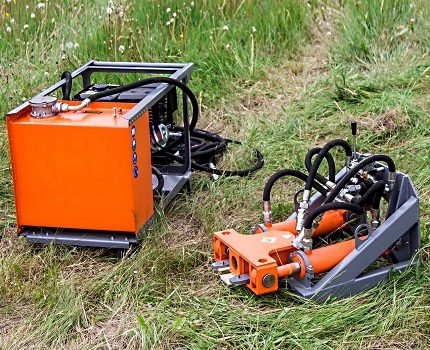
The difference in diameter is usually 150-250 mm, and the annulus is subject to backfill - filling with cement-sand mortar. Thus, the soil pressure on the working pipe is reduced, the load on it from transport is reduced, and protection from the effects of other communications located nearby is also provided.
The length of the casing segments ranges from 3 to 12 meters; during installation they are sequentially welded.
Differences in controlled puncture
This method differs from uncontrolled puncture in the additional use of deflectors - steel plates fixed in front of the casing. They are lifted using hydraulic cylinders, thereby correcting the direction of puncture.
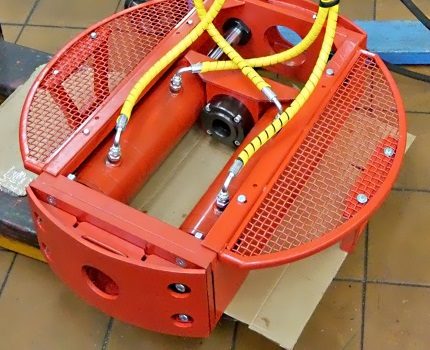
In both cases, to reduce friction, a bentonite solution is used, which is pumped out after laying the pipeline and can be reused after filtration.
More information about the technology of laying pipes by puncture can be found in this stuff.
The use of pneumatic perforators in dense soils
The use of pneumatic punches for soil puncture is the most inexpensive, fast and effective way, due to the relatively high accuracy of trenchless penetration.
This method does not require the manufacture of additional stops for hydraulic jacks, its use uses small and convenient equipment for transportation, and the minimum requirements for preparing a construction site are presented.
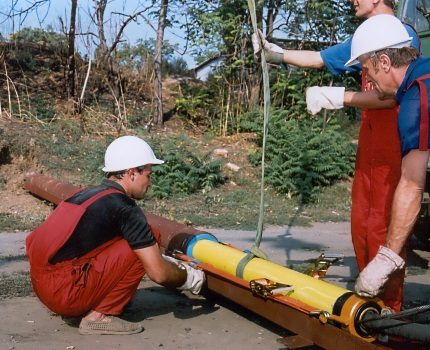
Due to the compressed air, sufficient impact energy is developed, under the influence of which an open steel pipe with a length of up to 80 meters is clogged into soils of high strength. The average laying speed is 15 meters per hour. After laying, the pipes are cleaned of soil with water and compressed air. Large diameter pipes are cleaned by hand.
Benefits of Microtunneling Technology
The microtunneling process is fully automated. Upsetting and working pipes are made not only of steel, but also of ceramics, fiberglass, cast iron and reinforced concrete. The average driving distance without reinstalling the jack station is from 100 to 250 meters.

The range varies from the type of soil, the power of the punching frame that the microtunnel complex is equipped with, and also from the material of the pipes used - depending on what compression force the pipe can withstand.
Use of directional screw drilling rigs
Engaging auger installations is a cheap alternative to microtunnelling. Such installations allow laying casing pipes with high accuracy and observing the design slope, which is important for gravity communications.
Restrictions on use can be quicksand and large solid inclusions of soil. The driving distance usually does not exceed 80 meters.
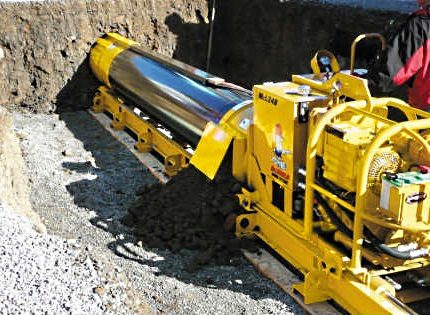
The use of augers with a hollow shaft allows drilling without developing a receiving pit.
Horizontal Directional Drilling Method
Perhaps this is the most expensive method of all existing in trenchless pipe laying, but also the most high-tech.
HDD is used not only when drilling long distances and laying pipes of large diameters is necessary, but also in those cases when it is required to lay a small section of a pipeline with a small diameter in the immediate vicinity of private estates or objects of cultural value.
In the process, drilling fluid is used, which provides a decrease in friction when pulling a whip of pipes, maintaining the developed soil in suspension to prevent compression of the laid material, cooling and lubricating the equipment, and removing developed soil to the surface.
Drilling mud is prepared by diluting with water bentonite - a natural mineral with a complex of special additives. The resulting suspension prevents channel collapse, eliminates the need for partial or complete pumping of groundwater, as it is able to perform its functions even in permeable soils.
Horizontal directional drilling in water-saturated soils requires precise control of the pressure and flow rate of the drilling fluid, as well as the use of special additives in its preparation.
Since the water for the preparation of the solution is taken from water bodies located in the immediate vicinity, it is necessary to take into account the presence of mineral salts and the pH of the groundwater, since these parameters can affect the stability of the suspension. This approach avoids uncontrolled erosion.
HDD work can be divided into several stages:
- drilling path planning;
- preparation of the place of work;
- execution of a pilot well;
- stage of well expansion;
- reverse pulling;
- restoration of the territory.
Consider each item in the plan.
Stage of planning and calculation of the well trajectory
Before drilling, it is required to calculate and plan the path of the well.
Take into account not only the length and depth of the path, but also possible obstacles, such as:
- soil compaction, its porosity and stickiness;
- moisture content and groundwater level;
- the presence of large stones and rocks;
- underground structures adjacent to the drilling zone.
Possible risks are identified and notifications are sent to emergency services and the Traffic Police Office.
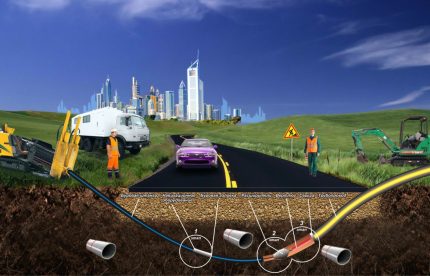
A drawing of a drilling trajectory is made or markup is made directly on the surface of the territory. With a serious engineering approach, the entry and exit angles of the drill, as well as the minimum allowable radii of curvature of the lash of the rods, are taken into account.
The greatest load on the installation occurs while expanding the pilot well and laying the pipeline, so the calculations are adjusted for the power of the equipment.
Organization of a venue for horizontal directional drilling
The HDD complex is delivered to the facility, unloaded, displayed at the place of work. It is necessary to verify the angle of inclination of the drilling frame and anchor the installation.
Without such a fastening, the drill itself, its drive and the drilling frame wear out faster, so fixing should not be neglected. Then you should make a test run of the mixer for the slurry and the unit's motors, and make sure that the hydraulic hoses are stable.
Pilot well completion
Pilot drilling consists in traversing the entire length of the trajectory of the well with a small diameter sufficient to extend the lash of rods. The first segment is loaded into the guide rod, the threaded connection is abundantly lubricated and connected to the drill head - a device consisting of a transmitter of the location system, the drill blade itself, and also a suspension feed filter.
Then the bentonite solution is supplied and the pressure is adjusted - this is required in order to make sure that the suspension passes through the hoses to the drill rod, enters the barrel, filter and nozzles of the drill head, and then leaves with the desired pressure.
The installation operator performs an inlet perpendicular to the soil surface relative to the longitudinal axis of the drill head, after which it performs drilling, successively increasing the lash of the rods.
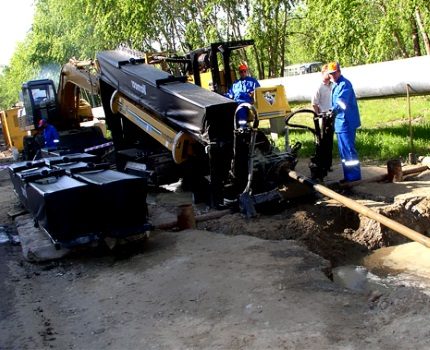
The operator of the location system makes marks of positions, depth and angle of drilling, checks the planned path and puts the actual path on the plan, if reorientation is required. After the drill head appears at the exit point, the pilot drilling is completed.
Stages of well expansion and tunneling
In the process of pilot drilling, a well with a width of 75-100 mm is formed, which is enough when laying communications of small diameter. If the diameter of the well is narrower than required, then a reamer expander is pulled in the opposite direction.
Often this stage is combined with the laying of communications, then a swivel is installed behind the rotating expander so that the material being laid does not twist.
In some cases, taking into account the efforts required to tighten, the well is separately expanded so that the tunnel size ensures the laying of the material of the desired diameter.
Reverse pulling is also performed with the supply of drilling fluid to reduce the friction of the material on the walls of the well. As the lash is tightened by the length of the rod, the HDD operator turns off the suspension, stops rotation and disconnects the rod, and then resumes the installation.
The procedure is repeated until the expander appears from the inlet of the well.
Completion and restoration of landscaping
After the trenchless laying of the pipeline is completed, the installation engine is turned off, the lined communications lane is disconnected, the connectors, swivel and filter are removed.
All devices are cleaned from the ground, treated with waterproof grease. The remainder of the suspension is pumped out, the pit is filled up and, if possible, the natural or near-natural landscape is restored.
Conclusions and useful video on the topic
Drilling a well with improvised means at a private site:
Video about applying the relining method:
The principle of renovation is the destruction of a steel pipe:
Step-by-step instructions for using the compact HDD installation:
The use of a trenchless method of laying communications implies the use of special equipment and certain devices. However, for short distances, a well with a diameter of 50-100 mm can be drilled with conventional electrical appliances at hand. The main thing is to make the calculations correctly.
Still have questions, find flaws in our material, or can you add valuable information to it? Please leave your comments in the block under the article.

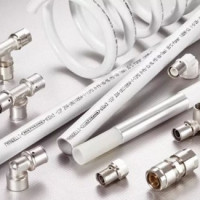 Press fittings for plastic pipes: types, marking, purpose + installation example
Press fittings for plastic pipes: types, marking, purpose + installation example 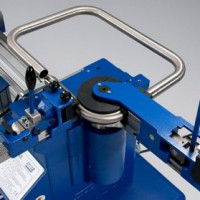 How metal pipes are bent: technological subtleties of work performance
How metal pipes are bent: technological subtleties of work performance 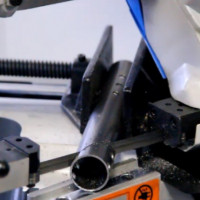 Pipe cutting at an angle: advantages and disadvantages of different methods + example of work
Pipe cutting at an angle: advantages and disadvantages of different methods + example of work 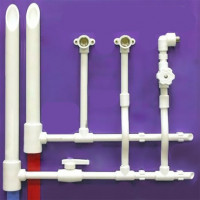 Installation of a water supply system from polypropylene pipes: typical wiring diagrams + installation features
Installation of a water supply system from polypropylene pipes: typical wiring diagrams + installation features 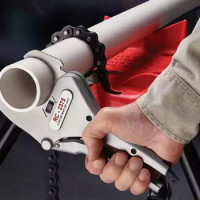 Pipe cutting equipment: types of tools and features of their application
Pipe cutting equipment: types of tools and features of their application 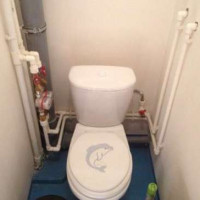 Replacing pipes in the toilet from A to Z: design, selection of building materials, installation work + error analysis
Replacing pipes in the toilet from A to Z: design, selection of building materials, installation work + error analysis  How much does it cost to connect gas to a private house: the price of organizing gas supply
How much does it cost to connect gas to a private house: the price of organizing gas supply  The best washing machines with dryer: model rating and customer tips
The best washing machines with dryer: model rating and customer tips  What is the color temperature of light and the nuances of choosing the temperature of the lamps to suit your needs
What is the color temperature of light and the nuances of choosing the temperature of the lamps to suit your needs  Replacement of a geyser in an apartment: replacement paperwork + basic norms and requirements
Replacement of a geyser in an apartment: replacement paperwork + basic norms and requirements